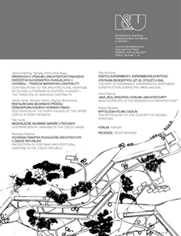RESTAUROVÁNÍ SEVERNÍHO PRŮČELÍ ČESKOKRUMLOVSKÉHO HORNÍHO HRADU
CONSERVATION OF THE NORTH FACADE OF THE UPPER CASTLE IN ČESKÝ KRUMLOV
Author(s): Miloslav Hanzl, Dagmar Michoinová, Václav GirsaSubject(s): Cultural Essay, Political Essay, Societal Essay
Published by: Historický ústav SAV, v. v. i.
Keywords: historic monument; landmark; conservation; evaluation; authenticity; materiality
Summary/Abstract: In parallel with the completion of work on the main southern facade of the Krumlov castle, it became necessary in 2004 to focus attention on the preparation of the highly demanding general conservation of the reverse side of the Upper Castle (Horní hrad), its northern facades. Contrasting to the southern, more firmly massed southern side of the Upper Castle, the northern side manifests a highly evident differentiation of outline as well as height. This result is given by the gradual enlargement of the volume of the building over time, and its penetration outside of the boundaries of the original castle. When viewed from the east, northeast or north, this effect strengthens the plasticity of the architecture and the dramatic tension of the visual image of the entire castle complex. The remarkable assemblage of massive volumes on the northern side of the Upper Castle has until now been insufficiently valued in terms of its artistic qualities and its aesthetic impact, and quite unjustly so throughout the 20th century. As a result, we are faced with severe decay in certain parts, and the exceptionally repugnant appearance of large sections of the exterior of the New Palace, brutally covered during the 1970s with sprayed grey-blue cement stucco. Nonetheless, much of the reason for ignoring the facade was its having been hidden, almost from “time immemorial”, by a practically impenetrable wall of thick vegetation of well-grown trees – up until precisely the date of May 15, 2002. On this day, within only a short time, the greater part of this vegetation was entirely destroyed by a whirlwind, and thus revealed these previously forgotten yet surprising views, as well as angles of viewing this central landmark of Český Krumlov from near and far. During preparation of the conservation work, a major role was held by the experience acquired during the conservation of the western and southern facades of the Upper Castle, since the extensive and highly articulated northern facade displayed (in comparison with the southern one) not only analogous themes but many quite essential differences, and implied much higher demands on the part of structural and conservation work. Much as in the case of the western and southern facades, a key principle even during the preparation for this stage was displaying a full respect for the set preservationist or ‘conservative’ approach to safeguarding. Because a more general validity of this conceptual approach to historic preservation has still failed to become common, particularly in the case of exceptionally authentic monuments, it is worth recalling its grounding principles: – Respect for the surviving appearance of the authentic monument is one of the key premises. Retention of the authentic appearance of an ageold built work should not be viewed as an inflexible dogma, but as an inherent sense of caution, responsibility for not disturbing something quite rare, irreplaceable, impossible to return to its original state..
Journal: Architektúra & Urbanizmus
- Issue Year: 45/2011
- Issue No: 1-2
- Page Range: 20 - 33
- Page Count: 14
- Language: Czech

